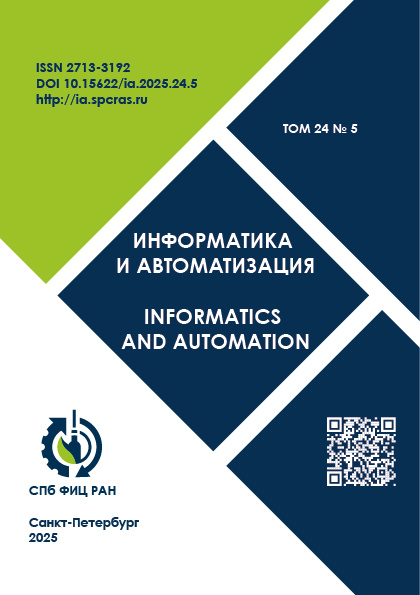Том 19, № 5 (2020)
Искусственный интеллект, инженерия данных и знаний
Контекстно-управляемый подход к интеллектуальной поддержке принятия решений на основе цифровых следов пользователей
Аннотация
 915-941
915-941


Робототехника, автоматизация и системы управления
Анализ устойчивости роя гетерогенных роботов с ограниченным полем зрения
Аннотация
Представлен анализ устойчивости роя гетерогенных роботов, где каждый робот имеет разный уровень чувствительности сенсоров и различные физические ограничения, включая максимальную скорость движения и ускорения. Каждый робот обладает уникальной областью восприятия в условиях ограниченного поля зрения. Изначально предлагался децентрализованный метод навигации для роя гетерогенных роботов, состоящего из ведущего робота и многочисленных ведомых роботов. Сдецентрализованным методом навигации ведущий робот может направлять ведомых, поддерживая соединение и учитывая физические ограничения, уникальные для каждого робота. Данное исследование сосредоточено на анализе устойчивости равновесия такого роя ргетерогенных роботов. С математической точки зрения доказывается, что когда ведущий робот двигается с постоянной скоростью, форма и направление всех остальных ведомых роботов в конечном счете стремятся к равновесию. Чтобы продемонстрировать совпадение этого состояния равновесия, сперва необходимо доказать, что оно существует. Проводятся эксперименты и численные моделирования, чтобы подтвердить наличие стабильности, то есть достижение роем роботов состояния равновесия.
 942-966
942-966


Цифровые информационно-коммуникационные технологии
Модель функционирования канала спутниковой связи в условиях искажений служебной части кадров нестационарными помехами
Аннотация
 967-990
967-990


Унифицированная речеподобная помеха для средств активной защиты речевой информации
Аннотация
 991-1017
991-1017


Алгоритм и технические решения динамического конфигурирования клиент-серверных вычислительных сетей
Аннотация
 1018-1049
1018-1049


Информационная безопасность
Проблемные вопросы информационной безопасности киберфизических систем
Аннотация
 1050-1088
1050-1088


Современные методы обеспечения целостности данных в протоколах управления киберфизических систем
Аннотация
 1089-1122
1089-1122












